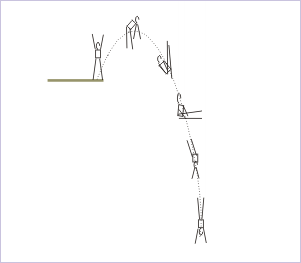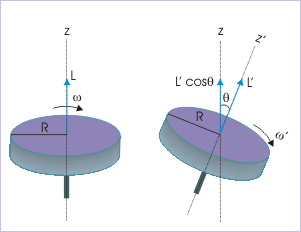| << Chapter < Page | Chapter >> Page > |
3: Ice skater
An ice skater rotates with outstretched hands on one leg. When he/she folds the hands and two legs closer to the axis of rotation, the moment of inertia of the body decreases. As a consequence, ice skater begins to spin at much greater angular velocity.
4: Spring board jumper
The spring board jumper follows a parabolic path of a projectile. In this case, the motion is about an accelerated axis of rotation, which moves along the parabolic path. In the beginning, the jumper keeps hands and legs stretched. During the flight, he/she curls the body to decrease moment of inertia. This results in increased angular velocity i.e. more turns before the jumper hits the water.
Spring board jumping

When the spring board jumper nears the water surface, he/she stretches hands and legs so that he/she she has straight line posture ensuring minimum splash while hitting water surface.
For applying conservation of angular momentum, we measure angular momentums in the context of some events like change in the distribution of mass, angular velocity etc. that arises from internal forces (torques).
The fundamental aspect of measurement of angular momentum is that its measurement should be about the same reference before and after the event. This is the basic requirement for applying law of conservation of angular momentum. We know that measurements of angular momentums about different points are different. Hence, we should stick to same set of points for measuring angular momentum so that the single value property of this physical quantity could be maintained.
If the axis of rotation (for the case of rotation) changes direction, then we should consider conservation in terms of the components of angular momentum about mutually perpendicular axes of rotation. Since angular momentum is a vector quantity, we can always find its component in the reference direction.
Rotation about an axis changing orientation

The measurement of angular momentum of a system, however, could involve complexity for the following two reasons :
As far as rotation is concerned, we deal it about an axis of rotation. There is no ambiguity involved here. What about translation? The measurement of angular momentum for non-rotational motion is about a point in the plane of motion of the particle or the particle like body. Usually, we would prefer (not required) that the point is on the axis of rotation, if the particle interacts with a rotating part of the system.
If a system consists of bodies rotating about different axes, then we should stick to the same axes for subsequent (after case) time for calculating angular momentum. As per the requirement of problem, we may, then, combine angular momentums, using vector addition to find the net or resultant angular momentum.
System with more than one axes of rotation

All these aspects of measurement of angular momentum are illustrated with detailed explanation in the next module titled " Conservation of angular momentum (application) ".
1. Law of conservation of angular momentum
Definition : If there is no external torque on a system, then the angular momentum of the system can not change.
In general,
For rotation,
The rotational form of conservation law is suited for rotation of rigid body that changes its mass distribution due to internal forces or where constituent parts of the system change their angular velocities.
2. Law of conservation of angular momentum in component form
Definition : If the net component of external torques on a system along a certain direction is zero, then the component of angular momentum of the system in that direction can not change.
If “x”,”y” and “z” represent three mutually perpendicular axes, then :
By corollary, component form of conservation law means that consideration of angular momentum in a given direction is not affected by torques in directions perpendicular to that direction.

Notification Switch
Would you like to follow the 'Physics for k-12' conversation and receive update notifications?